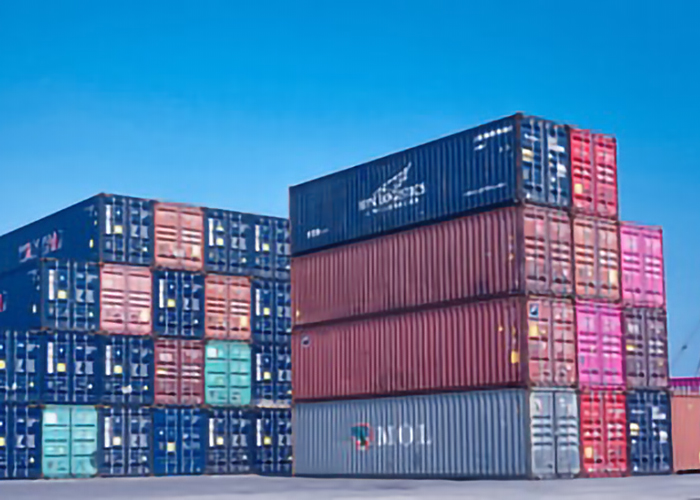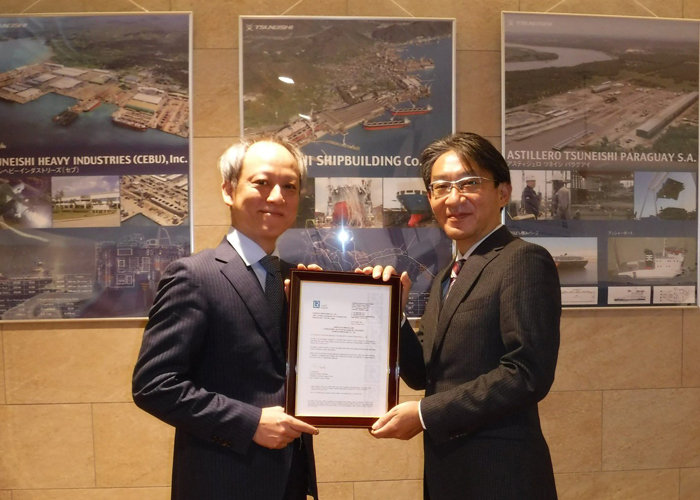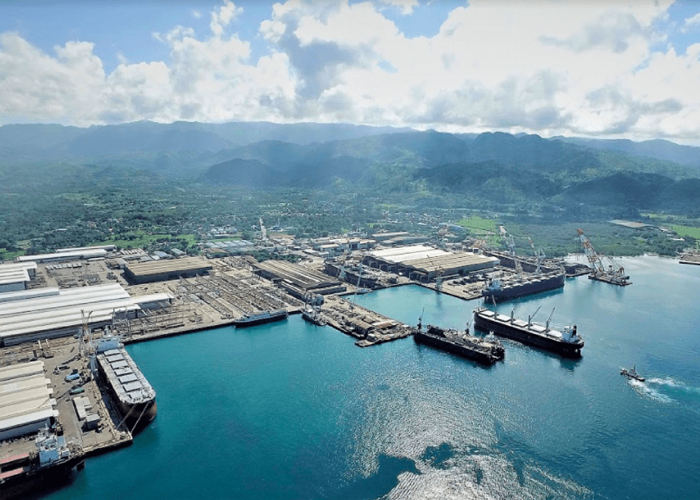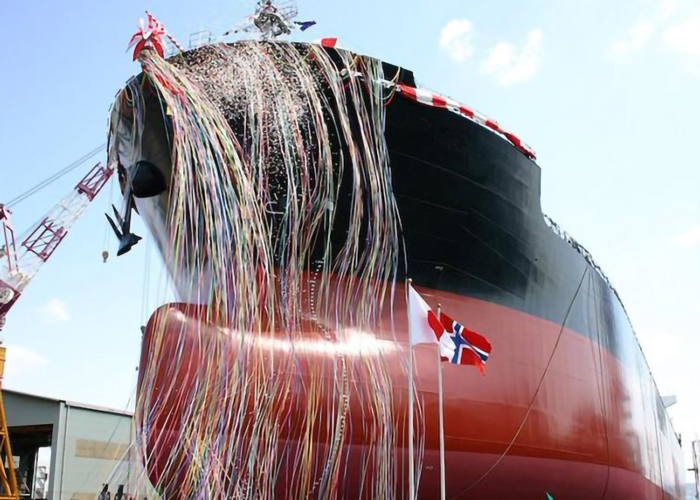
by cebudigital | Jul 4, 2022 | Uncategorized
TSUNEISHI SHIPBUILDING Co., Ltd. (HQ: 1083 Tsuneishi, Numakuma-cho, Fukuyama, Hiroshima, Japan; President: Sachio Okumura; hereafter TSUNEISHI SHIPBUILDING) has signed a contract with an owner in Japan to build four LPG carriers. The first ship is scheduled to be completed at Tsuneishi Factory in 2023.
The LPG carrier will have a 5,000m3 cargo tank capacity, an overall length of about 99m, a breadth of 17.6m, and a depth of 8m. This ship retains the versatile main dimensions of the 5,000m3 LPG ship class. It features a hull form that reduces propulsion resistance and the newest main engine to comply with the CO2 emission regulations of EEDI (1) Phase 3. Equipped with SCR (2), this LPG carrier qualifies as an eco-ship with excellent propulsion and environmental performance that satisfies the requirements of the NOx Tier III regulations.
For the design and the construction of the cargo tank and related systems, which are crucial for building LPG carriers, TSUNEISHI SHIPBUILDING is collaborating with highly experienced Mitsui E&S Shipbuilding Co., Ltd. (HQ: 6-4, Tsukiji 5-chome, Chuo-ku, Tokyo, Japan; President: Isamu Funatsu). By combining the expertise of both companies, TSUNEISHI SHIPBUILDING will construct ships that balance the economy of energy efficiency with the reduction of environmental impact.
*1 EEDI: Energy Efficiency Design Index is a technical measure mandated by international treaties of the IMO (International Maritime Organization), made applicable to newly-built ships with the aim of gauging and reducing their CO2 emissions.
*2 SCR: Selective Catalytic Reduction is an exhaust gas treatment equipment that reduces the NOx (nitrogen oxide) emissions generated by engines to a level that satisfies the requirements of the NOx Tier III regulations.
About the LPG carrier:
Length x breadth x depth: About 99m × 17.6m × 8m
Cargo tank capacity: 5,000m3
Draft: 6.1m
Gross tonnage: 4,800

by cebudigital | Jul 4, 2022 | Uncategorized
LR has awarded Tsuneishi Shipbuilding Co., Ltd. with an Approval in Principle (AiP) for its Kamsarmax Bulk Carrier, which has been designed for dual-fuel operation, using both Liquefied Natural Gas (LNG) and Fuel Oil.
The Kamsarmax vessel is equipped with a fuel gas supply system (FGSS) and IMO Type-C LNG tank, meaning LNG fuel can be used and stored with limited impact on cargo capacity.
Measuring 229-meters, Tsuneishi Shipbuilding’s new LNG dual fuel Kamsarmax is suitable for berthing at the Port of Kamsar (Republic of Guinea), where the major loading terminal is restricted to vessels of up to 229-meters in length.
Regulations on exhaust emissions from ships are becoming stricter and the demand for compliant ships is increasing. An LNG-fuelled vessel, such as Tsuneishi Shipbuilding’s Kamsarmax vessel, can significantly reduce sulphur oxides (SOx), nitrogen oxides (NOx), and carbon dioxide (CO2) in engine exhaust gas.
Sachio Okumura, President of Tsuneishi Shipbuilding Co. Ltd., said “With the needs for environmental performance of ships increasing year by year, Tsuneishi Shipbuilding has been accelerating its research and development into environmentally-friendly technologies. The “Kamsarmax Gas Fuel” plays an important role in the transition from heavy oil-fuelled ships to next-generation ships fuelled by hydrogen, etc. We will continue our efforts at sales activities so that our ships can help solve the problems of many customers who are dealing decarbonisation challenges.”
Seiji Hamanaka, LR Yokohama Technical Support Office Manager, said “We are proud to support Tsuneishi Shipbuilding with its ongoing decarbonisation efforts by awarding Approval in Principle for its LNG dual-fuel bulk carrier design. Since its creation in 2005, Tsuneishi Shipbuilding has been further enhancing its Kamsarmax design to align with everchanging regulations and requirements, and this is the next step towards meeting the IMO’s GHG emission targets.”
Tsuneishi Shipbuilding first designed/developed and named the ship category ‘Kamsarmax’ in 2005.

by cebudigital | Jul 4, 2022 | Uncategorized
The Aboitiz Group and its Japanese partner are set to expand the West Cebu Industrial Park (WCIP), which is expected to create thousands of new jobs for communities in the coastal municipality of Balamban, Cebu.
Cebu Industrial Park Developers, Incorporated (CIPDI) – a joint venture between Aboitiz and the Tsuneishi Group – is the developer of WCIP, which will be expanded by 30 hectares in 2022. The ground breaking for the project is set for next year.
Rafael Fernandez de Mesa, First Vice President for Operations of the Aboitiz Integrated Economic Centers, said in a press statement that their vision is “to transform WCIP into a fully integrated economic center that will spur further economic growth in the area.”
He likened this to their other developments: LIMA Estate in Batangas and Mactan Economic Zone II in Lapu-Lapu City, Cebu.
“With its strategic location, skilled population, lower cost of doing business, and well-established ecosystem of infrastructure, we believe that WCIP is the ideal location for light, medium, and heavy industries looking to expand or locate in Cebu,” added De Mesa.
Despite economic conditions worsened by the COVID-19 pandemic, the Aboitiz Group believes the expansion project would attract locators seeking more industrial spaces, and the development of commercial centers, transport terminals, dormitories, and even leisure components for tourists.
Eduardo Aboitiz, Vice President for Business Development of the Aboitiz Integrated Economic Centers, welcomed Advanced Catamaran Composites as its third shipbuilding firm in WCIP.
“We are excited to have Advanced Catamaran Composites as our newest locator in the West Cebu Industrial Park. With our 30-hectare expansion set to break ground next year, we are hoping to attract more locators to Balamban,” Aboitiz said.
“WCIP is only set to grow further, and now is the perfect time to invest here,” he added.
CIPDI began developing WCIP in 1992. which later turned Balamban into the shipbuilding capital of the Philippines. WCIP is strategically located on the west side of Cebu, known to be a major industrial belt due to its proximity to various access points.
The initial success of WCIP enabled the estate to grow from 202 to 540 hectares. More than 14,000 skilled workers have been employed by its industrial and commercial locators.
WCIP now forms a portion of the 540-hectare property in Balamban which hosts 11 locators from medium to heavy industries within its allocated 283-hectare Philippine Economic Zone Authority (PEZA)-registered zone.

by cebudigital | Jun 4, 2022 | Uncategorized
TSUNEISHI SHIPBUILDING, MITSUI O.S.K. LINES and MITSUI E&S SHIPBUILDING start Joint Development on Net Zero Emission Ammonia-fueled Ocean-going Liquefied Gas Carrier
TSUNEISHI SHIPBUILDING Co., Ltd. (President: Sachio Okumura; Headquarters: Fukuyama-shi, Hiroshima), MITSUI O.S.K. LINES, Ltd. (President & CEO: Takeshi Hashimoto; Headquarters: Minato-ku, Tokyo), and MITSUI E&S SHIPBUILDING Co., Ltd. (President: Isamu Funatsu; Headquarters: Chuo-ku, Tokyo) today announced the launch of a joint project aimed at developing and building an ocean-going liquefied gas carrier that will use ammonia as its main fuel.
The vessel is envisioned as a mid-size ammonia/LPG carrier equipped with a main engine that can run mainly on ammonia, and targeting to achieve net zero carbon dioxide (CO2) emissions while underway by using some of its ammonia cargo as fuel. This ship type is in the mainstream of ammonia carriers used for international maritime ammonia transportation, therefore, the vessel is able to call at major ammonia and LPG shipping and receiving ports around the world, meaning it can be used on a broad range of routes.
The three companies continue to move toward the joint development and design of the ship, and plans delivery and introduction of the vessel around 2026 as the first “net zero emission ocean-going vessel.
In line with trends toward decarbonization, worldwide interest in ammonia fuel—which emits no CO2 during combustion—is growing as a next-generation clean energy source. So the move to strategically use ammonia as fuel has been accelerating in the maritime industry as well. The three companies will offer clean ocean transport solutions with net zero emission vessels and play a part in comprehensive efforts to realize a decarbonized society, while anticipating and responding to rising demand for ocean transport of ammonia.




